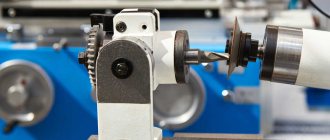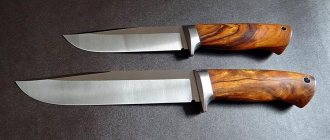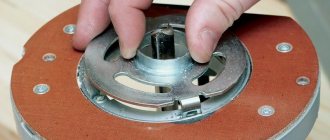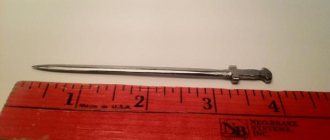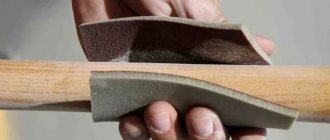Device characteristics
An electric metal marker (EM) has been used in production practice for about 40 years. It is known by many names:
- electric spark marker;
- electrograph;
- electric pencil;
- arcograph.
EM is often used for marking:
- metalworking tools;
- measuring instrument;
- cutting tool;
- printed circuit boards;
- all kinds of tags or nameplates;
- surgical instrument;
- dental instruments;
- all kinds of metal parts.
Structurally, the electric marker is a system of 4 parts:
- Portable power source (usually designed for power from a regular household electrical network with a voltage of 220 V and a frequency of 50 Hz ).
- A vibrator handle with a built-in light filter (it has a regulator of the vibration frequency of the working part of the device).
- Replaceable tips made of spring steel or tungsten wire (diameter from 0.5 to 1 mm)
- Clamp and cable for connecting to the metal surface being processed.
The physical principle of operation of EM is the rapid erosion of the surface of the metal product being processed by breaking down the gap between the electrodes. Their role is played by the working part of the device (cathode) and the metal surface of the product (anode). The treated surface is covered with a series of small holes, with a diameter of 0.1 to 2 mm.
Operating principle of an electric marker
The metal surface to be marked must be thoroughly cleaned of grease and oxide films. The latter noticeably worsen the conductivity of the metal, which forces an increase in the voltage in the interelectrode gap. The discharge results in a low duty cycle, but with coarser dimples, which deteriorates the quality of marking. The spark discharge power is controlled by a step switch.
The following geometric characteristics of the hole are considered optimal for these purposes:
- Width – 0.2…2.0 mm;
- Depth – 0.15…20 µm;
- The speed of marker movement on the surface is up to 10 mm/s.
The kit of some models of electric markers for metal also includes a steel plate, equipped with fasteners for fixing the part that is being marked.
The sequence of working with an electric marker for metal is as follows. The device is connected to a household power supply with a voltage of 220 V and a frequency of 50 Hz through an autonomous power supply. The part to be marked is attached to a metal plate using an alligator clip. In order to protect the operator’s eyes, the vibration device is covered with a special filter, after which the electrographic pen is brought to the surface, which is covered with a thin (2...3 mm) layer of liquid dielectric. First, a test discharge is performed, during which the optimal speed of movement of the electrographic pencil along the surface of the product is established. As the pen moves, new processing areas are wetted with the dielectric.
To set up an electrographic marker for metal, you must perform the following steps:
- Set the vibrator frequency to the required mode. To do this, use (depending on the size and manufacturer of these devices) one of the following methods: either optimize the sound signal (as the oscillation frequency decreases, the permissible value of the interelectrode gap increases), or adjust the frequency by changing the brightness of the signal light.
- The switch sets the required current value. It is usually maximum for metals with low thermal conductivity (most non-ferrous metals and alloys), and less for aluminum, steel or cast iron.
- By moving the electrode-tool along the required trajectory of movement, marking is made. The overall dimensions of the symbols have no restrictions.
- When working with an electric marker, it should be remembered that increasing the voltage and current of the electrical discharge beyond the required speeds up the wear of the electrode and does not lead to a significant increase in the productivity of the process. Wear is especially intense in the event of a short circuit (occurs when there is a lack or absence of dielectric fluid on the marked surface of the product). For guidance, you can use standard wear values of 0.05...0.2 mm per mark.
- To correct an erroneously applied mark, the surface must be sanded.
The use of an electric pencil requires the operator to have certain skills and experience. The duration of continuous use of an electric spark marker is not fundamentally limited, although if the device operates for more than 30...40 minutes, the pulse generator unit warms up. Replacement of a worn cathode-tool is carried out with the device turned off. The electric metal marker should not be used in rooms where the relative air humidity exceeds 75%.
Principle of operation
Main stages of EM operation:
- Cleaning the treated surface from dirt, grease and oxide film. This must be done to increase the conductivity of the metal and the possibility of using a relatively small operating voltage in the space between the electrodes.
- Attention! If the conductivity of the metal is low (for example, due to contamination of its surface), then an increase in operating voltage will be required. And this will lead to a low duty cycle of the discharge and rougher traces of processing on the metal
- Connecting the metal part being processed to the EM using a clamp and cable.
- Attention! Often the EM delivery kit includes a special metal plate. It is convenient to place the part on it and connect the power cable to it
- Coating the metal surface with a uniform layer of mineral oil. Oil, being a dielectric, helps to concentrate the released thermal energy and significantly reduce the force applied to tear the electrode off the surface if it sticks. In addition to the above, oil helps to avoid short circuits.
- Attention! It is strictly not recommended to use other liquids, such as water or even electrolytes, instead of mineral oil.
- The device sets the starting current operating characteristics: 30 V, 40 mA.
- Attention! Most modern electric vehicles belong to the second electrical safety class. Standard precautions when working with electrical equipment must be carefully observed. Also, you should not work in rooms with high humidity (more than 70%)
- The vibration frequency of the vibrator is adjusted (according to the manufacturer's instructions).
- A test touch of the part is made with the working part of the EM. Depending on the required parameters of the applied holes, the device settings change.
- Attention! Most modern electric vehicles have a protective shield - it prevents the eyes from being damaged by the bright light of an electric spark. But you shouldn’t rely only on him, and you shouldn’t be too careless
- The actual application of digital, alphabetic or other information to the surface is carried out. In this case, the speed of movement of the working part of the EM along the surface being processed should range from 1.5 to 10 mm per second.
- Attention! Normal wear of the working electrode should not exceed 0.2 mm per medium-volume treatment. With more intensive wear of the electrode, it is necessary to change the operating parameters towards their reduction.
- After completion of work, the EM is de-energized and disconnected from the workpiece. Its surface is cleared of oil.
DIY electric spark pencil
Often there is a need to make an inscription or drawing on the metal panel of the device being created. There are many ways to make inscriptions or drawings on metal: chemical etching, mechanical engraving and a number of others. We will talk about one of them - electric spark engraving.
This method will require an alternating current source with a voltage of 18-20 V, preferably adjustable, and an electrode holder - an electric spark pencil.
A transformer with a power of about 200 W can be used as a current source. One of the terminals of the secondary winding of the transformer is connected using an alligator clip to the workpiece or part on which the inscription needs to be applied. The other terminal is connected to an electrode clamped in an electric spark pencil. Connections are made with an insulated stranded wire with a cross-section of at least 1.5 mm2, ensuring operation with currents of more than 10 A. The connection diagram is shown in Fig. 1.
Fig. 1 Connection diagram of an electric spark pencil to a 220 volt network
An electric spark pencil is a simple clamp for an electrode, the basis of which can be used as a regular collet pencil (Fig. 2). However, due to the high degree of heating during engraving, its plastic body must be replaced with another made of heat-resistant insulating material, for example, PCB or ebonite. The wire coming from the transformer is passed through a hole in the housing and soldered to the collet.
Rice. 2 Electric spark pencil based on a regular collet pencil
The electrode can be a pointed metal rod with a diameter of 02-3 mm, preferably made of a refractory metal, for example, tungsten. But you can use rods from other materials, say, from less scarce graphite. The engraving end of the rod is a cone with an apex angle of about 30°.
When the transformer is connected to the network according to the diagram above, voltage appears on the electrode. Touching the end of the electrode to a metal surface causes a spark discharge to appear, which, melting the metal surface, leaves a noticeable mark on it.
Experience shows that the highest quality inscriptions are obtained at an operating voltage for a tungsten electrode - 8-10 V, for a graphite electrode - 16-18 V. Before applying an inscription, the metal surface must be cleaned of dirt and degreased. Inscriptions and drawings are applied with separate points and tangential movements.
'If desired, an electromagnetic breaker can be introduced into the electrical circuit of the “electric spark pencil”, connected in series to the circuit it breaks, and the pencil can be equipped with a solenoid (in the core of which the collet is fixed) and a spring that returns the collet with the electrode to its original state after opening the circuit. This will somewhat simplify the engraving process, but will complicate the design of the electric pencil.
When operating the described device, it is necessary to observe electrical safety measures, especially when using LATR as a voltage source. To protect your eyes, you must always use safety glasses. Do not allow the transformer to overheat, take breaks during operation.
S. IVANOV, Kursk
Advantages of electric markers and their standard sizes
An electric marker for metal has a number of advantages over other devices for applying information to metal surfaces:
- the product is not subject to mechanical stress; it can be any thin-walled or complex configuration.
- Attention! The operation of the EM is relatively simple, but still requires a certain skill and careful preliminary calibration of the device
- the treated surface is not subject to corrosion and has a clearly visible matte finish.
- ability to work with various metals and their alloys: steel, titanium, zirconium, iron, copper, aluminum and many others.
- ease of removing the applied pattern - to do this, you just need to re-polish the metal in this place (since the depth of the holes does not exceed 1.5-2 mm ).
- comparative efficiency of the device - at maximum settings it consumes no more than 30-50 W.
- Possibility of long-term continuous operation of the EV - it has built-in overheating protection.
Most EVs have small overall dimensions (on average about 160x130x90 mm) and low weight (from 1,000 to 1,500 g)
The best models. How to choose
Currently, there are five EV models that are most common on the market. We present their characteristics in the table below.
| Model name | Manufacturer, Country | Size of the applied hole, microns | Maximum character size, mm | Operating voltage, V | Operating current, mA | Power, W | Average price, according to at the beginning 2022 |
| EVZ-021 | Josef Solnar (Czech Republic) | 10×10 | Up to 50 | 220…230 | 200 | 20 | 15000 |
| Progress-001 | (Russia) | 10×10 | Is not limited | 220…230 | 400 | 50 | 8000 |
| EVZ-022 | Josef Solnar (Czech Republic) | 20×50 | Is not limited | 220…230 | 450 | 50 | 20000 |
| AG25/3 | Arglo AG (Switzerland) | 20×20 | Is not limited | 4 | 5000 | 25 | 20000 |
| AG50/6 | Arglo AG (Switzerland) | 20×50 | Is not limited | 6,5 | 6500 | 50 | 25000 |
When choosing an EV, they are usually guided by the ratio of the parameters price - performance - maintainability. Therefore, in our country they usually choose a device produced in St. Petersburg - the Progress - 001 electric metal marker.
